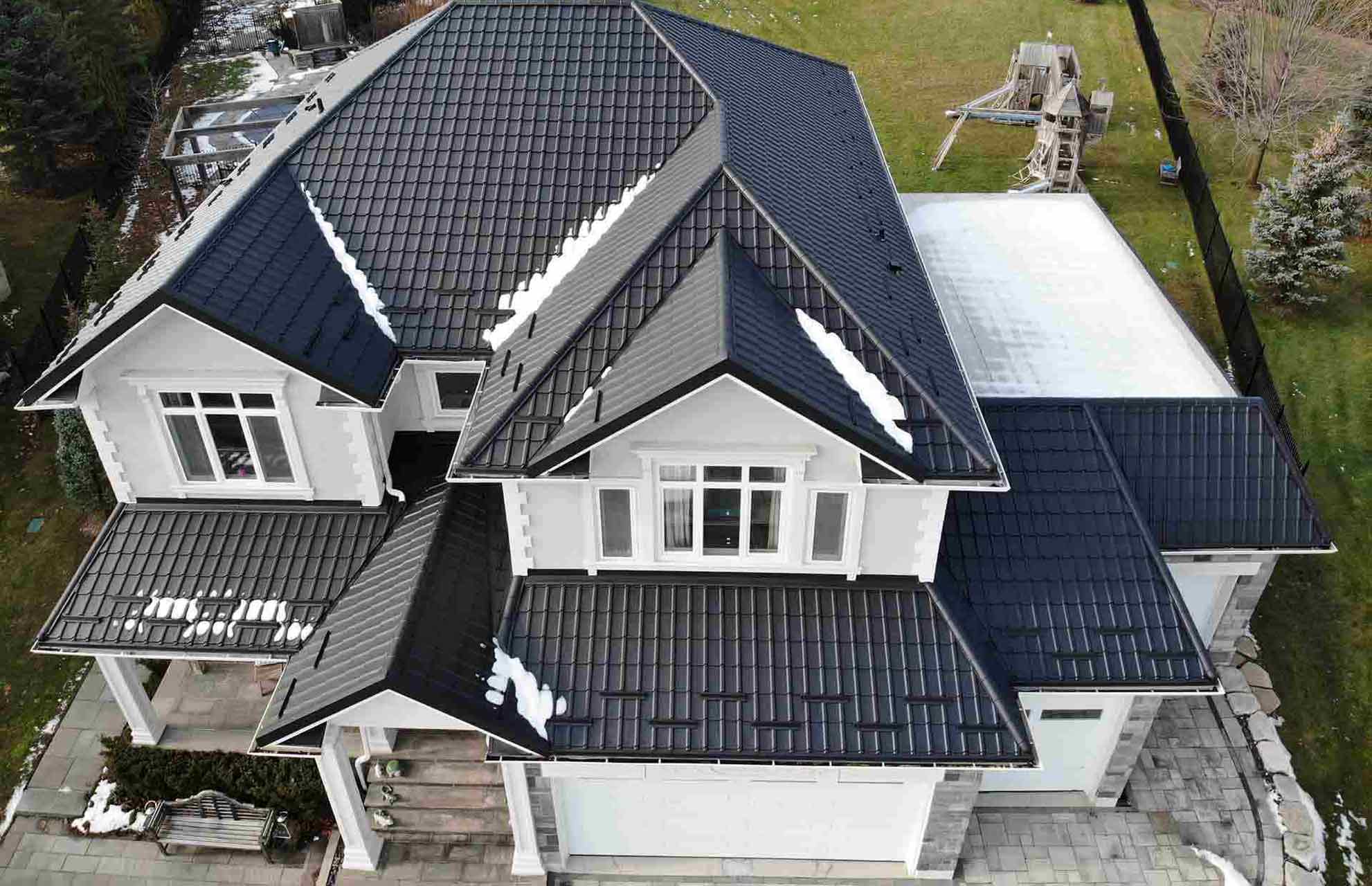Your metal roofing may be your best line of defense against the severe winter weather. It is in charge of defending your home from the ground up. So, before the cold winter begins, make sure your roof is ready for the job. Here are 5 ways to winterize your roof and have peace of mind during the cold and snowy months.
Check and clear gutters
Gutters are essential for safeguarding your roof. They gather rainfall and divert it away from your property. They help preserve your foundation by preventing water from accumulating around the base of your property. When they get blocked though, they can create a slew of issues. Clogged gutters can not only allow pests to enter your property, but they can also retain water, causing damage to your roof, siding, or foundation. This trapped water in your gutters can develop potentially damaging ice dams in the winter. Heavy ice may cause gutters to separate from the roof or even collapse, exposing your entire property to flood damage. Before winter rolls in, it is a good idea to verify that your gutters are not blocked. You may clean them yourself or engage a gutter cleaning service to remove the leaves, twigs, muck, and other debris that has accumulated in order to keep the water flowing smoothly. Another option is to invest in gutter guards to prevent clogs from occurring in the first place.
In addition, When cleaning up your gutters before the winter, keep an eye out for signs of animal infestations. Your roof may be home to squirrels, raccoons, birds, bees, bats, wasps, and hornets. For your own safety, you should get any live animals removed by a pest control professional. Also, beware that indicators of animal infestation may be too high up for you to observe or reach with your ladder. While performing your winter roof inspection, your roofing specialist will check for evidence of animals living under your roof in your attic.
Pre-winter roof inspection
No one wants a roof leak, yet it is overlooked that frequent inspections may help avoid roof leaks. It is a good idea to obtain a spring roof inspection to spot concerns and get your roof repaired before the rainy season. A winter roof checkup is also a good idea to discover minor faults that might evolve into leaks if left untreated. Regular checks are smart investments that can save you on repairs and early roof replacement down the line. Why should you have your roof inspected in the fall rather than another season?
Roofing specialists may be less active during the autumn, as they deal with emergency and reroofing work all summer. As a result, contacting a roofer for a fall inspection may be best to get an appointment with a reliable contractor. However, do not leave it too late in the season. You want to have enough time to solve problems before the snow begins falling. It is critical to fix any issues with your roof before the cold season hits.
Roofs may be fixed and installed in the winter on occasion, but it is more difficult for the roofing specialist and more uncomfortable for you. What should you expect if you contact a roofing specialist for a fall roof inspection? A proper roof examination cannot be performed from the ground. The roofing specialist will climb on their ladder and carefully walk around on your roof. They will inspect every visible element of the roof to ensure that it is in good operating order.
Inspect attic insulation and ventilation
The weather is set to turn much colder in the winter months. For that reason, good attic insulation and adequate attic ventilation are two of the most important methods to remain warm, save money on utilities, and safeguard the integrity of your metal roofing or any type. Insulation keeps heat in so you spend less money running your furnace.
Proper insulation also keeps the surface cooler, which is critical for preventing ice dams and the damage they may cause. If you experienced an ice dam last year, have a roofing specialist inspect your insulation and ventilation and advise you on if it needs to be replaced. They may also urge you to add extra ice and water protection during a new roof installation to prevent damage from ice dams.
While in your attic, your roofing specialist may search for symptoms of leaks and animal infestation, as well as inspect your attic ventilation. Ventilation allows moisture to exit your attic. Moisture may build up in your attic and condense on various surfaces if it is not properly ventilated. The resulting water may cause damage to your home’s frame or other components.
Repair any damage before the winter months
After you have inspected your roof it is key to repair any of the damages you have come across. It is vital that repairs be completed in the fall months to avoid further damage in the winter with snow and low temperatures prevalent. Repairs, even minor ones, should be completed once they are discovered and it is best not to put them off. A common issue with any roof is the sign of water leakage. For metal roofing specifically, the cause of the leak can be a number of reasons, and uncovering the cause can assist in how to repair it.
As an example, The metal paneling on your roofing system is joined together by one of two main types of fasteners: clips or rubber washer fasteners. The clips fasten in a way that conceals the metal seam laps. They often use a sealer (such as acrylic or urethane) to bind the entire roof’s metal panels together. Self-drilling fasteners with rubber washers can be spaced as near as every two square feet. By positioning them in close proximity, the seam laps of the metal panels are retained flat without the extra necessity of a sealer or butyl tape. These fasteners can come out over time, leaving holes or gaps in the metal seam laps that allow water in and pave the way for potential problems down the line. Fixing this issue may require a professional metal roofer to assess and remedy it.
Install snow guards for added safety
When a winter storm blows around your home, a large amount of snow falls on the roof. Later, when the snow melts, a layer of water accumulates between the roof and the snow, which can cause the snow to abruptly release and slide down the roof in enormous sheets. Snow falling from your roof can damage or shatter your roofing materials, injure surrounding property, or result in serious bodily injury. Snow guards are roof-mounted devices that collect and disperse accumulated snow and ice. Snow guards on your roof allow layers of snow or ice to melt gradually rather than rolling down the surface in a big sheet. Snow guards are especially beneficial on buildings with metal roofing since these materials have less friction and prevent snow from sliding down the roof.
With new snow guards for your roof you can benefit from:
Better Home Safety: The sheets of snow that might fall from your roof are typically huge and heavy. If an individual or an animal gets trapped beneath the snow, they might sustain serious injuries. Which snow guards can prevent.
Long-term metal roofing protection: When snow mounds fall off a roof, they can cause cracking and other roof damage, compromising the structural integrity of your roofing and causing leaks and damage to your structure. This damage is potentially hazardous and expensive to remediate.
Property damage prevention: Snow buildup not only causes possible harm to your roofing materials, but the weight of the snow may also break and distort your gutters, eventually causing them to detach from your structure. Snowfall and melting can also damage HVAC systems and landscaping, as well as flood your home’s foundation.
Winterizing your metal roofing can involve a handful of different tasks to ensure it can hold up against the harsh weather of the winter. Being prepared in the fall can ensure that you and your roof can withstand the coming months. This may include clearing any debris from the top or clearing the gutters. It may also include inspecting for damage and readily repairing any issues. Lastly, you may consider snow guards which is a preventive measure that can ensure no damage is done to your roof or harm is done to anyone nearby. The winter months can be a stressful time for you and your metal roofing but it does not have to be.


